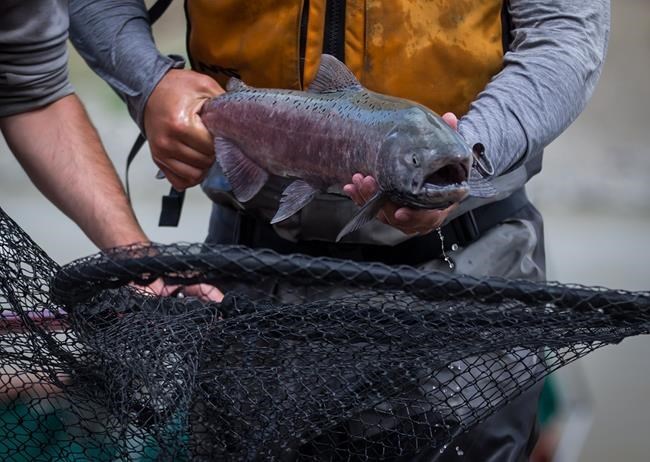VANCOUVER — Thousands of migrating sockeye and chinook salmon are making their way over a massive rock slide on British Columbia's Fraser River this summer where barely 100 fish were counted for the entire season three years ago, Fisheries and Oceans officials said Friday.
The most recent salmon numbers from Aug. 9 pegged 280,000 chinook and sockeye at an area located about 40 kilometres past the slide site.
"What we're seeing is pretty good passage results right now at the slide site, upwards of 39,000 salmon are passing through the Big Bar area on a daily basis," said Gwil Roberts, a Fisheries and Oceans slide response official.
"We are seeing (river) flows that are advantageous to chinook and sockeye passage," he said.
The Big Bar area of the river is a remote site north of Lillooet. The slide was first reported in June 2019.
About 110,000 cubic metres of rock fell into the river's canyon, creating an almost impassable barrier for migrating salmon.
The provincial and federal governments worked with First Nations to find solutions to get the salmon past the slide site.
Gord Sterritt, a director of the Upper Fraser Fisheries Conservation Alliance, an Indigenous-led group, said there is anticipation within their communities about the potential arrival and harvest of wild salmon.
"It just sort of helps their cultural values and brings a sort of excitement to the communities, and I can say there's many communities in the Upper Fraser now that are very excited that there's fish returning," he said.
Past rescue efforts to get the trapped salmon beyond the slide included shooting them through a so-called salmon cannon, capturing them and using a truck or helicopter to take them past the site, and moving huge boulders into the river to create a pathway to help ease the fish beyond the slide zone.
"Mother Nature has its ways, as we've seen over many decades of monitoring through the (Fraser) Canyon," said Roberts. "Sometimes we have good years and sometimes we have heavy challenges. Big Bar posed a massive challenge in 2019."
The Fisheries Department is forecasting up to 10 million sockeye could return to the Fraser River this summer, while commercial fishers are also reporting large runs of sockeye this year on the Skeena River in northwest B.C., and off Barkley Sound on Vancouver Island.
Fisheries project spokesman Dale Michie said this year's salmon faced delays along the Fraser River due to high waters in the spring, but the fish arriving at the slide site have been able to continue their migration.
But he said despite this year's better returns, the spawning cycles connected to the years when the slide blocked many salmon will likely result in diminished returns of salmon for the next two years at least.
— By Dirk Meissner in Victoria
This report by The Canadian Press was first published Aug. 12, 2022.
The Canadian Press




